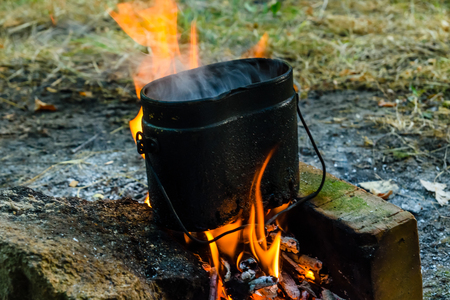Introduction to Spring Campfire Cooking
As the chill of winter fades and nature begins to bloom, spring brings the perfect opportunity to enjoy the outdoors—and theres no better way to celebrate than with some good old-fashioned campfire cooking. Whether youre a seasoned camper or just getting started, spring is one of the best times to cook outside. The mild temperatures, longer daylight hours, and fresh seasonal ingredients make it an ideal season for outdoor meals.
Unlike the sweltering heat of summer or the biting cold of winter, spring offers a comfortable environment for setting up camp and enjoying your surroundings. Birds are chirping, flowers are blooming, and the air feels fresh—setting the mood for relaxing around a crackling fire while preparing a delicious meal.
Why Spring Is Ideal for Campfire Meals
Spring offers unique advantages that make it especially great for campfire cooking:
| Reason | Description |
|---|---|
| Mild Weather | Comfortable temperatures make it easier to cook over an open flame without overheating or freezing. |
| Fresh Ingredients | Spring produce like asparagus, ramps, peas, and strawberries can elevate your meals with vibrant flavors. |
| Fewer Bugs | Compared to summer, there are generally fewer insects to deal with when cooking or eating outdoors. |
| Less Crowded Campsites | Early in the season, popular camping spots tend to be less busy, offering a more peaceful experience. |
Getting Your Gear Ready
Before heading out, its important to prep your gear so youre ready for successful springtime meals. Here are some essentials you’ll want to have on hand:
- Cast Iron Skillet or Dutch Oven: Durable and versatile for everything from stews to skillet cornbread.
- Grill Grate: Useful for placing over your fire pit for direct grilling.
- Fire Starters and Dry Wood: Spring weather can be damp, so bringing dry kindling and starters is key.
- Cooler with Ice Packs: Keep perishable ingredients fresh during transport.
- Long-Handled Utensils: Protects your hands while flipping food over hot flames.
Mental Prep: Embrace Flexibility and Simplicity
Campfire cooking is as much about the experience as it is about the food. Spring weather can be unpredictable—so stay flexible. Maybe you’ll need to adjust your meal plans if rain hits or if certain ingredients aren’t available at local markets. Go with the flow and keep things simple. Even basic meals taste amazing when cooked over a fire surrounded by friends or family in nature’s embrace.
This season is all about reconnecting—with nature, with others, and with food itself. So get your gear together, plan some easy seasonal recipes, and head outside to savor the magic of spring campfire cooking.
2. Essential Campfire Cooking Gear
When it comes to spring campfire cooking, having the right tools can make all the difference. Whether youre flipping pancakes at sunrise or roasting veggies at sunset, these essentials will help you cook safely and efficiently over an open flame.
Must-Have Cookware
Spring camping means unpredictable weather and varied menus, so versatile cookware is key. Cast iron is a favorite among campfire cooks for its durability and even heat distribution. Heres a quick look at essential cookware options:
| Gear | Why You Need It |
|---|---|
| Cast Iron Skillet | Perfect for searing, frying, and even baking over the fire. |
| Dutch Oven | Ideal for stews, soups, and one-pot meals that simmer slowly. |
| Grill Grate | Makes it easy to grill meats and vegetables directly over the flames. |
| Heat-Resistant Gloves | Keeps your hands safe while handling hot pots and pans. |
Fire-Starting Tools
No fire means no food! Be sure to pack reliable fire-starting gear, especially in damp spring conditions. Here are some basics every camper should bring:
- Waterproof Matches or Lighter: Always have more than one way to start a fire.
- Fire Starters or Kindling: Wax-coated cubes or natural tinder help get your fire going fast.
- Hatchet or Folding Saw: Useful for cutting wood if youre collecting from nearby sources (where allowed).
Safety Essentials for Campfire Cooking
Cooking over an open flame requires attention to safety—especially in the breezy spring season when sparks can fly. Keep these items on hand to stay prepared:
- Fire Extinguisher or Bucket of Water: Always have a way to put out your fire quickly if needed.
- First Aid Kit: Burns and cuts happen—be ready to treat minor injuries right away.
- Long-Handled Utensils: Keep hands away from the flames while cooking.
Quick Tip:
Packing gear in labeled storage bins can make setup easier and keep everything organized during your trip. Try separating tools into categories like “Cooking,” “Fire Starting,” and “Safety.”
Your Spring Campfire Toolkit Checklist
| Item | Status | |
|---|---|---|
| Cast Iron Skillet | ☐ | |
| Dutch Oven | ☐ | |
| Grill Grate | ☐ | |
| Heat-Resistant Gloves | ☐ | |
| Waterproof Matches/Lighter | ☐ | |
| Fire Starters/Kindling | ☐ | |
| Hatchet/Folding Saw | ☐ | |
| Bucket of Water/Fire Extinguisher | ☐ | |
| First Aid Kit | ☐ | |
| Long-Handled Utensils | ☐ | |
Having these essentials packed and ready will set you up for a fun—and delicious—springtime adventure around the campfire.
![]()
3. Spring Seasonal Ingredients and Where to Find Them
Spring is a fantastic time to explore fresh, seasonal ingredients that bring color and flavor to your campfire cooking. Whether youre foraging in the wild or browsing your local farmer’s market, spring offers a variety of ingredients perfect for easy, delicious outdoor meals.
Fresh Finds at the Farmer’s Market
Your local farmer’s market is a great place to stock up before heading out on a camping trip. These markets are packed with locally grown produce that’s in season and full of flavor. Here are some common spring finds:
| Ingredient | Flavor Profile | How to Use It |
|---|---|---|
| Asparagus | Earthy and slightly sweet | Grill over the fire with olive oil and salt |
| Spring Onions | Mild and tangy | Sauté or grill as a side dish |
| Radishes | Crisp and peppery | Add raw to salads or roast near the fire |
| Peas (snap or snow) | Sweet and crunchy | Toss into foil packets with other veggies |
| Fresh Herbs (like mint, parsley, chives) | Aromatic and bright | Add at the end of cooking for freshness |
Foraging for Wild Greens and Herbs
If youre feeling adventurous, foraging can be a fun way to add wild flavors to your campfire meals. Just make sure you’re 100% certain about what you’re picking—some plants can be toxic if misidentified. Here are some common edible plants found in many parts of the U.S. during spring:
| Wild Plant | Description | Common Use |
|---|---|---|
| Dandelion Greens | Bitter green leaves from dandelion plants | Sauté with garlic or mix into salads |
| Wild Garlic (Ramps) | Mild garlicky flavor, found in wooded areas | Use like scallions in recipes or grill whole |
| Nettle Leaves (use gloves!) | Nutrient-rich but sting when raw—cook before eating | Add to soups or sauté like spinach after boiling |
Tips for Foraging Safely:
- Use a reliable field guide or app to identify plants.
- Only pick from clean, pesticide-free areas.
- If in doubt, don’t eat it—stick with known edibles.
- Harvest responsibly—take only what you need.
Packing Your Spring Pantry for Campfire Cooking
If foraging isn’t an option or youd rather prep ahead, consider bringing pre-washed greens and herbs from home. Many supermarkets now carry spring produce that’s ready-to-use and perfect for quick campsite meals. Keep items chilled in a cooler until youre ready to cook.
No matter where your ingredients come from—wild trails or weekend markets—using whats in season makes your campfire meals fresher and more flavorful. Spring is natures invitation to get creative outdoors!
4. Signature Spring Campfire Recipes
Spring is the perfect season to enjoy fresh flavors and outdoor cooking. Whether youre camping in the woods or just enjoying a backyard fire pit, these easy campfire recipes will bring seasonal ingredients to life with minimal effort. From foil-pack meals to sweet treats, here are some step-by-step ideas that are fun, family-friendly, and full of springtime flavor.
Foil-Pack Spring Chicken and Veggies
Ingredients:
- 1 boneless chicken breast (per person)
- 1/2 cup sliced baby potatoes
- 1/4 cup chopped asparagus
- 1/4 cup cherry tomatoes (halved)
- 1 tbsp olive oil
- Salt, pepper, garlic powder to taste
- Fresh rosemary or thyme (optional)
Instructions:
- Tear off a large sheet of heavy-duty aluminum foil.
- Place chicken breast in the center and surround with veggies.
- Drizzle with olive oil and season with spices and herbs.
- Fold foil tightly into a packet, sealing all edges.
- Place over medium campfire coals for about 20–25 minutes, flipping halfway through.
- Carefully open packet and check that chicken is cooked through before serving.
Grilled Spring Veggie Skewers
Ingredients:
- Zucchini slices
- Mushrooms
- Bell peppers (any color), chopped
- Red onion chunks
- Olive oil and balsamic vinegar
- Salt, pepper, Italian seasoning
- Bamboo skewers (soak in water 30 mins before using)
Instructions:
- Toss veggies in olive oil, balsamic vinegar, and seasonings.
- Thread onto skewers in alternating patterns.
- Grill over campfire grate for 8–10 minutes, turning occasionally until tender and slightly charred.
S’mores with a Twist: Strawberry Shortcake S’mores
Ingredients:
- Graham crackers
- Large marshmallows
- Sliced fresh strawberries
- White chocolate squares or spreadable cream cheese frosting
Instructions:
- Toast marshmallow over fire until golden brown.
- Place white chocolate or frosting on one graham cracker square.
- Add a few strawberry slices and the toasted marshmallow on top.
- Cover with another graham cracker square and gently press together.
Campfire Fruit Cobbler Foil Packs
Main Ingredients Table:
| Ingredient | Amount (per pack) |
|---|---|
| Sliced peaches or berries (fresh or canned) | 1/2 cup |
| Cake mix (vanilla or yellow) | 2 tbsp dry mix |
| Pats of butter | 1–2 small pieces |
| Cinnamon (optional) | A pinch |
Instructions:
- Add fruit to the center of a foil sheet.
- Sprinkle cake mix evenly over fruit.
- Add butter on top and cinnamon if using.
- Seal foil into a tight packet.
- Cook over low campfire heat for 15–20 minutes until bubbly and golden.
- Caution: Contents will be hot! Let cool slightly before eating directly from foil or spoon into bowls.
This spring, enjoy fresh air, good company, and these delicious campfire recipes that make cooking outdoors simple and satisfying. All you need is a fire, a few ingredients, and your appetite!
5. Campfire Cooking Techniques and Safety Tips
Spring is the perfect season to enjoy the outdoors and cook up fresh, seasonal meals right over your campfire. Whether youre a seasoned camper or just getting started, mastering a few core cooking techniques can make your spring camping trips even more memorable—and delicious.
Mastering Core Campfire Cooking Methods
There are several tried-and-true methods for cooking over a campfire. Each one brings out different flavors and textures in your food. Here are three key techniques every camper should know:
| Cooking Method | Description | Best For |
|---|---|---|
| Open Flame Grilling | Place food directly on a grill grate above the flames. Use skewers or a grilling basket for small items. | Burgers, hot dogs, veggies, fish fillets |
| Cooking Over Hot Coals | Let your fire burn down to glowing embers and place cookware over or near the coals for steady heat. | Foil packet meals, roasted potatoes, corn on the cob |
| Dutch Oven Baking | Use a cast-iron Dutch oven with coals placed underneath and on top of the lid to create an oven-like effect. | Bread, cobblers, stews, casseroles |
Essential Fire Safety Tips
Campfire cooking is fun, but safety always comes first. Follow these important tips to keep your spring adventure safe and enjoyable:
- Choose the Right Spot: Always use designated fire rings or pits. Keep fires at least 15 feet away from tents and flammable materials.
- Control Your Fire: Don’t build a fire bigger than needed. Keep it manageable and never leave it unattended.
- Keep Water Nearby: Have a bucket of water or a shovel and dirt nearby in case you need to extinguish the fire quickly.
- Extinguish Completely: Before heading to bed or leaving camp, douse your fire with water and stir until all embers are cold to the touch.
- Avoid Aerosols and Flammable Liquids: Never use lighter fluid or aerosol cans near open flames—they’re extremely dangerous.
Pro Tips for Better Campfire Cooking
- Pre-prep Meals at Home: Chop veggies, marinate meats, and portion spices before your trip to save time at camp.
- Use Heavy-Duty Foil: For foil packet meals, double wrap in heavy-duty foil to avoid tearing over coals.
- Add Wood Gradually: Avoid flare-ups by adding small amounts of wood as needed instead of piling it all on at once.
- Cook with Patience: Let coals develop fully before cooking—food burns easily over open flames but cooks evenly over embers.
With these techniques and safety practices in your toolkit, youll be ready to whip up amazing springtime meals under the stars—all while keeping your campsite safe and stress-free.
6. Making the Most of Your Spring Camping Experience
Spring is a time of renewal, and there’s no better way to celebrate it than by combining great food with the great outdoors. Whether youre camping in a national park or at your favorite local campsite, campfire cooking can be more than just making meals — its about creating moments that stick with you long after the season ends.
Pairing Meals with Outdoor Activities
Planning your meals around your outdoor plans helps you stay energized and enjoy each moment. Heres a quick guide to help you match meals with common spring camping activities:
| Activity | Meal Idea | Why It Works |
|---|---|---|
| Morning Hike | Oatmeal with dried fruits and nuts | Quick to make, high in fiber and energy-boosting ingredients |
| Afternoon Kayaking | Grilled chicken wraps with spring greens | Light but filling, easy to pack for on-the-go meals |
| Fishing Trip | Campfire-grilled fresh catch with lemon and herbs | Makes use of your catch, celebrates freshness of spring |
| Evening Stargazing | Smores and hot cocoa | A classic treat that sets the mood for cozy nighttime vibes |
Creating Memorable Mealtime Moments
A big part of what makes spring camping special is how you share meals. Here are some simple ways to turn ordinary campfire meals into lasting memories:
- Cook Together: Involve everyone in meal prep — even kids can help wash veggies or wrap foil packs.
- Dine Al Fresco: Spread out a picnic blanket or set up a folding table under the trees. Nature makes the best dining room.
- Add a Touch of Home: Bring a small tablecloth, reusable plates, or even some fairy lights for ambiance.
- Tell Stories: Share tales from past camping trips while roasting marshmallows — it’s all part of the experience.
Embracing Spring Through Food and Nature
This season is bursting with color, flavor, and life. Let your campfire menu reflect that! Incorporate fresh seasonal ingredients like asparagus, ramps, strawberries, and wild mushrooms (only if youre confident they’re safe). Try these ideas to bring spring onto your plate:
Spring-Inspired Campfire Recipes:
- Foil Pack Veggie Medley: Toss sliced carrots, asparagus, red potatoes, and onions in olive oil and herbs; wrap in foil and cook over coals.
- Lemon Herb Grilled Trout: Stuff freshly caught trout with lemon slices and dill before grilling over an open flame.
- Berries & Cream Skillet Dessert: Warm mixed berries in a cast iron skillet over the fire; top with whipped cream or biscuit dough for a rustic cobbler.
The key is to slow down and savor both your surroundings and your food. With the scent of blooming flowers in the air and birdsong in the background, every bite becomes a celebration of spring itself. So go ahead — light up that campfire, gather your crew, and let nature do its magic at mealtime.


